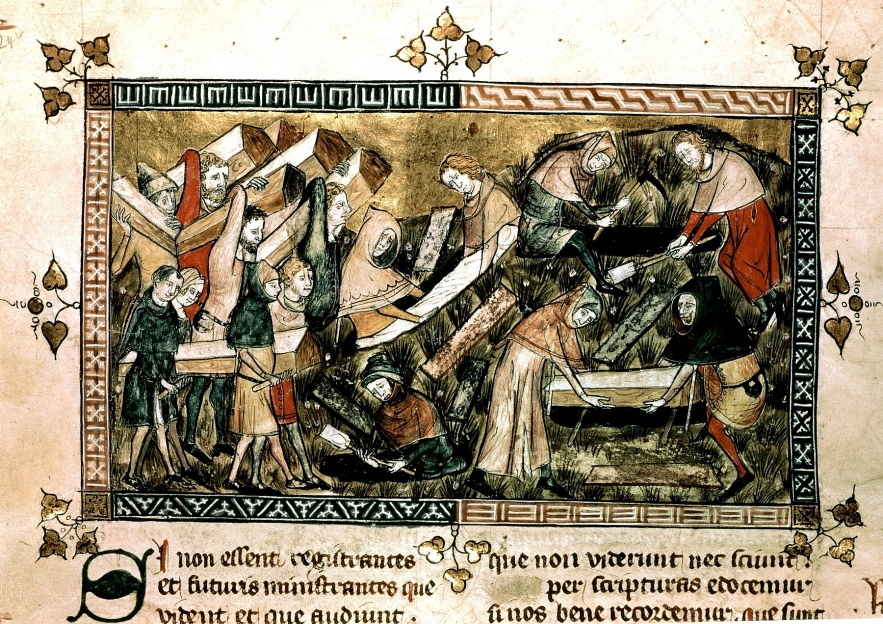Top 10 Deadliest Pandemics In The World Of All Time
 |
| The 10 World Deadliest Pandemics In History |
What is pandemic or epidemic?
Medical researchers have for years have differed over the exact definition of a pandemic (or an epidemic), but one thing everyone agrees on is that the word describes the widespread occurrence of disease, in excess of what might normally be expected in a geographical region.
Cholera, bubonic plague, smallpox, and influenza are some of the most brutal killers in human history. And outbreaks of these diseases across international borders, are properly defined as pandemic, especially smallpox, which throughout history, has killed between 300-500 million people.
Throughout history, disease has afflicted millions of people in many parts of the world causing much pain and suffering in the form of illness, disability, and death. The word pandemic means an epidemic of infectious disease that has spread through human populations across a large geographic region; for instance multiple continents, or even worldwide. Pandemics originate from microscopic enemies, such as parasites, viruses and bacteria, which may be passed to us from infected people,animals, or insects.
The Short List of the top 10 World's Deadliest Epidemics In History
| 1. BLACK DEATH PLAGUE ~ 140 - 375 million deaths |
| 2. SPANISH FLU ~ 50 million deaths |
| 3. AIDS PANDEMIC ~ 36 million deaths |
| 4. PLAGUE OF JUSTINIAN ~ 30 million deaths |
| 5. THIRD PLAGUE PANDEMIC ~ 22 million deaths |
| 6. COCOLIZTLI EPIDEMIC ~ 10 million deaths |
| 7. AZTEC SMALLPOX EPIDEMIC ~ 7 million deaths |
| 8. ANTONINE PLAGUE ~ 5 million deaths |
| 9. ASIAN FLU ~ 3 million deaths |
| 10. PERSIAN PLAGUE ~ 2 million deaths |
Related: Black Death - Facts about the World's Worst Pandemic in History
The 10 Worst Pandemics In the World of All Time In Detail
10.Persian Plague
Number of Deaths: Around 2 million
Time: 1772 – 1773
Affected regions: Persian Empire (modern-day Iran, Iraq, Bahrain), to a lesser degree also modern-day Pakistan & India
Disease: Bubonic Plague
Caused by: Yersinia Pestis bacteria
Infection through: Oriental rat fleas carrying the bacteria, infecting people through flea bites.
Origin Sourse: The epidemic started in Bagdhad in the winter of 1772. The rats with the infected fleas then quickly spread throughout the Persian Empire and especially along the Persian Gulf coast, eventually reaching Bahrain. In the East, the bacteria reached as far as modern-day Mumbai, India. The epidemic didn’t last long, but was extremely mortal with thousands of deaths being recorded per day at the peak of the outbreak. Only imposed quarantine measures in Persia managed to eventually contain the epidemic by the end of 1773.
9.Asian Flu
Number of Deaths: Around 3 million deaths (some estimates go as high as 4 million)
Time: 1956 – 1958
Affected regions: China, Hong Kong, Singapore, to a lesser degree also USA & Europe
Disease: Influenza (a.k.a. Flu)
Caused by: Influenza A H2N2 Virus
Infection through: Infected humans spread the virus to others by coughing and sneezing.
Origin Sourse: The Virus originated in China, where it may have transferred and mutated to humans from ducks. The virus quickly spread to neighboring Hong Kong and to Singapore by sea. The virus also reached Europe and the United States, where it claimed around 70,000 lives. The epidemic was controlled and eventually entirely stopped by the development of an effective vaccine in 1957.
8. Antonine Plague
Number of Deaths: Around 5 million deaths (some estimates go as high as 8 million)
Time: 165 – 180
Facts:
Also known as the Plague of Galen, the Antonine Plague was an ancient pandemic that affected Asia Minor, Egypt, Greece, and Italy and is thought to have been either Smallpox or Measles, though the true cause is still unknown. This unknown disease was brought back to Rome by soldiers returning from Mesopotamia around 165AD; unknowingly, they had spread a disease which would end up killing over 5 million people and decimating the Roman army.
Based on the described symptoms of the infected, the epidemic was most likely caused by a measles or smallpox outbreak, which Roman soldiers, merchants or diplomats may have brought to Europe from China, where especially smallpox outbreaks were relatively common. In Europe, both viruses were unknown at the time and the Europeans therefore had not formed an immunity against either disease yet. Once the epidemic reached Rome, the most populated city in the world back then, it killed 1/3 of the city’s entire population.
Affected regions: Roman Empire (especially Rome itself, where 1/3 of the population perished)
Disease: Unknown (possibly Measles or Smallpox)
Origin Sourse: The origin of the epidemic and the disease remain largely unknown.
SARS: Original, CauseSevere Acute Respiratory Syndrome (SARS) is a serious case of pneumonia, which was first reported in 2003 when an outbreak spread across numerous countries in North and South America, Europe, and Asia. Originating in China, the virus spread from small mammals to people infecting over 8,000 people in a matter of weeks and took 774 people lives. Although SARS did not claim a large number of lives, it made the top list because it is demonstrates viral mutation from an animal to human infection and changed the way we respond to global spread of infectious disease with the current fluidity of worldwide travel. SARS is caused by the coronavirus, and is spread much like the common cold, through close person-to-person contact and respiratory coughs and sneezes. Fortunately, there have been no further outbreaks of SARS, although the World Health Organization has designated it as a global threat. |
7. Smallpox Epidemic
Number of Deaths: Around 7 million deaths
Period: 1520 (with constant smaller outbreaks until 1951 all over Latin America)
Affected regions: Aztec Empire (modern-day Mexico)
Facts: Following a 12,000-year scourge, smallpox claimed between 300 and 500 million lives. Now it has been eradicated through successful worldwide vaccination.
Over time, Smallpox ravaged the world as a contagious and fatal disease that caused raised bumps, or ‘pox’ over the kin of a person’s face and body and multi-system failures killed 30% of its victims. Interestingly, our presidents George Washington, Andrew Jackson, and Abraham Lincoln all contracted and recovered from smallpox. The last case in the United States was in 1949. Although the variola virus is eradicated, there is concern that the virus could be used as a bio-terrorism agent.
Disease: Smallpox
Caused by: Variola Major Virus & Variola Minor Virus
Infection through: Infected humans spread the virus through close face-to-face contact by little droplets of bodily fluids which contained the virus.
 |
| Smallpox Epidemic |
| Origin: Spanish colonizers (“Conquistadores”) led by Hernan Cortes invaded the Aztec Empire in 1519 and in the process inadvertently spread smallpox among the indigenous populations. Unlike the Europeans, the native Aztecs never dealt with smallpox before and therefore had not built up any immunization against the virus. Beginning in May 1520 and lasting until the end of that year, the virus quickly spread throughout the Aztec lands, even killing some notable Aztec leaders including Cuitlahuac, the ruler of the Aztec capital Tenochtitlan (modern-day Mexico City). |
6. Cocoliztli Epidemic
Number of Deaths: Around 10 million deaths (around 3/4 of New Spain’s contemporary population)(some estimates go as high as 15 million)
Time: 1545 – 1548
Affected regions: New Spain (modern-day Mexico & Guatemala)
Origin: The origin of the epidemic remains unknown. Some evidence points to the Spanish colonizers who conquered and settled what is now Mexico at the time. Newest DNA studies suggest that they may have inadvertently brought a rare European strain of the Salmonella enterica bacteria to the Americas and infected the native population. The usual Salmonella symptoms do not match the contemporary witness descriptions of the symptoms seen in the Cocoliztli Epidemic, however (Cocoliztli = “disease” in Nahuatl, the native Aztec language).
The described symptoms were high fever alongside a black tongue, vertigo, dysentery, chest pains and severe bleeding from the nose, eyes and mouth. The origin of the epidemic therefore remains largely unproven.
Influenza KillerInfluenza is the 7th largest killer in the U.S. today. Over the past 300 years, this virus has been responsible for three pandemics including the H1 Spanish Flu, H1N1 Swine Flu, and the H5N1 Avian (Bird) Flu. In 1918, the Spanish Flu devastated the population killing 50 million people. The most recent strain of Avian (Bird) Flu, the deadly virus known as H5N1, occurred in 2009. This virus is highly contagious causing serious outbreaks in domestic poultry in Asia and the Middle East. Although it usually doesn’t infect humans, there have been over 600 cases reported in 15 countries since 2003. Cholera KillerCholera is an acute intestinal infection caused by the bacteria Vibro cholera, which lives in contaminated water or food and can kill within hours if left untreated. Of the three to five million cases of Cholera every year, 100,000 to 120,000 result in death following severe fluid loss and diarrhea in excess of 10 liters per day. Fortunately, most cases can be treated successfully with simple oral rehydration. Cholera can be prevented with clean water and sanitation systems and is a very rare occurrence in industrialized nations. |
5. Third Plague Pandemic
Number of Deaths: Around 22 million deaths
Time: 1855 – 1960
Affected regions: Primarily China & India, to a lesser degree als much of the entire rest of the world
Disease: Bubonic Plague
Caused by: Yersinia Pestis bacteria
Infection through: Oriental rat fleas carrying the bacteria, infecting people through flea bites.
Origin: Rats from Central Asia, carrying infected fleas, brought the Yersinia Pestis bacteria to the Yunnan Province of China, where the epidemic started around 1855. The epidemic eventually spread to Hong Kong, back then a major trading post for the British Empire. From there on, merchants and sailors inadvertently spread the rats throughout most of the world with constant outbreaks on all continents. As a major trading partner, British-ruled India was especially hard hit by the pandemic as the bacteria spread especially fast throughout the Indian subcontinent.
Tens of millions of Indians perished from the Plague. The pandemic lasted more than 100 years until 1960, making it the longest pandemic in recorded history.
4. Plague of Justinian
Number of Deaths: Around 30 million deaths (some estimates go as high as 50 million)
Time: 541 – 542.
Facts: Thought to have killed perhaps half the population of Europe, the Plague of Justinian was an outbreak of the bubonic plague that afflicted the Byzantine Empire and Mediterranean port cities, killing up to 25 million people in its year long reign of terror. Generally regarded as the first recorded incident of the Bubonic Plague, the Plague of Justinian left its mark on the world, killing up to a quarter of the population of the Eastern Mediterranean and devastating the city of Constantinople, where at its height it was killing an estimated 5,000 people per day and eventually resulting in the deaths of 40% of the city’s population.
Affected regions: Byzantine Empire, especially its capital Constantinople (modern-day Istanbul) and practically all regions around the Mediterranean Sea (around 20% of the contemporary world population in total perished).
 |
| Plague of Justinian |
Disease: Bubonic Plague
Caused by: Yersinia Pestis bacteria
Infection through: Oriental rat fleas carrying the bacteria, infecting people through flea bites.
Origin: Oriental rat fleas, which carried the Yersinia Pestis bacteria, originated in Central Asia or East Asia. The rats with the fleas eventually spread to Egypt. From there on sailors inadvertently brought the rats with the infected fleas on ships to Constantinople (modern-day Istanbul). From there on the bacteria then spread throughout the coasts of the Mediterranean Sea. Among the infected was Justinian I., the emperor of the Byzantine Empire at the time. The epidemic was hence named after him (Justinian I. ended up surviving the disease, however).
| This was a particularly devastating pandemic killing up to 10,000 people a day in Constantinople alone. A disease, that is now believed to be the bubonic plague, claimed half the population of Europe in 541AD estimated at 25 million, which resulted in a serious labor and military shortage, resulting in the decline of the Byzantine Empire. It all started when a ship with rat-infested grain arrived in Constantinople, the capital of the Byzantine Empire and then went onto Egypt. Of course, the rats were infected with fleas that carried the Yersinia Pestis bacteria, responsible for Bubonic Plague |
3. AIDS Pandemic
Number of Deaths: Around 36 million deaths
Time: 1959 – ongoing
Affected regions: Almost all regions of the world, but especially Sub-Saharan Africa.
Disease: Acquired Immune Deficiency Syndrome(AIDS)
Caused by: Human Immunodeficiency Virus (HIV)
Infection through: Mainly through sexual contact with an infected person, but virus can also spread through blood transfusions, hypodermic needles, breastfeeding and to an unborn child of an infected mother during pregnancy.
Origin: The virus originated in Central Africa, more precisely in what is now the Democratic Republic of the Congo. For as of yet not completely clear reasons the Simian Immunodeficiency Virus (SIV) affecting chimpanzees, gorillas and other monkeys transferred into humans and mutated into HIV. The virus then quickly spread throughout Sub-Saharan Africa. In the early 1970s the virus arrived in the USA and from there on spread globally.
The Plague of AthensIn 430BC, Athens was brought to its knees by a deadly illness when as many as 75,000 to 100,000 people were infected, killing nearly 25% of the city. This plaque occurred during the early years of the Peloponnesian War, originating in Ethiopia and spread throughout the entire Mediterranean lasting for almost 5 years. With a mortality rate of 33%, the Plaque of Athens spread quickly within the walled city of Athens where the temperatures were hot, humid and there was also a poor water supply and no sewage system. It can be difficult to identify the source of this pandemic and researchers consider Smallpox, Typhoid, Rickettesia, Salmonella, Anthrax, or a super infectious flu as likely suspects |
2. Spanish Flu
Number of Deaths: Around 50 million deaths (some estimates go as high as 100 million)
Time: 1918 – 1920
Affected regions: Almost all regions of the world (27% of the contemporary world population got infected), primarily: USA, China, India, Western Europe, Western Africa, Eastern Africa, East Asia, South America
Disease: Influenza (a.k.a. Flu)
Caused by: Influenza A H1N1 Virus
Infection through: Infected humans spread the virus to others by coughing and sneezing.
Origin: The virus originated either in the USA or in China. Outbreak occurred in the last year of World War I, contributing to the rapid spread of the Influenza virus. Infected American soldiers brought the virus to Europe and Liberia, Africa (American colony at the time), from where it quickly spread throughout the entire world. Most nations involved in World War I censored any news about the pandemic in order to keep their troops’ morale high.
As a neutral party in the war, Spain was among the only affected countries to openly report about the Influenza A H1N1 outbreak, hence the pandemic became globally known as the “Spanish Flu”, even though it did not actually originate in Spain, nor was Spain the most affected nation.
1. Black Death Plague: 140 - 375 Million Deaths
 |
| The plague in Tournai, then part of France, as depicted in "The Annales of Gilles de Muisit" from the mid-14th century. (Photo 12/Universal Images Group via Getty Images) |
Numbers of Deaths: Around 140 million - 375 million)
Time: 1346 – 1353 (possibly much longer)
Affected regions: Mostly Europe (almost half of the contemporary European population perished), Middle East & North Africa (around 1/3 of the contemporary Middle Eastern & North African populations perished)
Disease: Bubonic Plague
Caused by: Yersinia Pestis bacteria
Infection through: Oriental rat fleas carrying the bacteria, infecting people through flea bites.
Origin Sourse: Oriental rat fleas, which carried the Yersinia Pestis bacteria, originated in Central Asia or East Asia. They then spread to the Crimean Peninsula following the Silk Road. From there on sailors inadvertently brought rats with the infected fleas on ships to Italy. Thus, the bacteria then rapidly spread practically throughout all of Europe with only some notable exceptions (e.g. Milan and the Kingdom of Poland).
| This could be the most infamous of all pandemics eventually claiming up to 375 million lives as it ravaged Europe and spread into Asia in the 14th century. Often referred to simply as The Plague it was transmitted by rats and fleas and even respiratory droplets spread when coughing. Starting in 1331, it is estimated to have claimed 30-60% of the population of Europe.1 |


























